A collection of tools for analysing cmdspanpy output, written in Python
Project description
A Python library for analysing cmdstanpy output
This is a collection of functions for analysing output of cmdstanpy library. The main idea is to do a quick data analysis by calling a single function that makes:
-
traceplots of samples,
-
text and plots of the summaries of model parameters,
-
histograms and pair plots of posterior distributions of parameters.
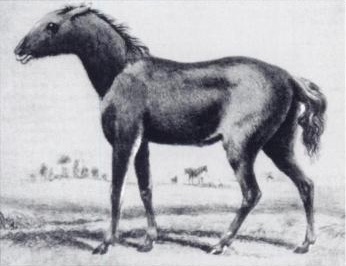
The only known illustration of a tarpan made from life, depicting a five month old colt (Borisov, 1841). Source: Wikimedia Commons.
Setup
First, run:
pip install tarpan
Finally, install cmdstan by running:
install_cmdstan
Complete analysis: save_analysis
This is the main function of the library that saves summaries and trace/pair/tree plots in model_info directory. The function is useful when you want to generate all types of summaries and plots at once.
from tarpan.cmdstanpy.analyse import save_analysis
model = CmdStanModel(stan_file="your_model.stan")
fit = model.sample(data=your_data)
save_analysis(fit, param_names=['mu', 'sigma'])
If you don't need everything, you can call individual functions described below to make just one type of plot or a summary.
Analysis without cmdstanpy
Here is how to analyse values from Pandas' data frame columns:
from tarpan.shared.analyse import save_analysis
save_analysis(df, param_names=['mu', 'sigma'])
Summary: save_summary
Creates a summary of parameter distributions and saves it in text and CSV files.
from tarpan.cmdstanpy.summary import save_summary
model = CmdStanModel(stan_file="your_model.stan")
fit = model.sample(data=your_data)
save_summary(fit, param_names=['mu', 'tau', 'eta.1'])
The text summary format is such that the text can be pasted into Github/Gitlab/Bitbucket's Markdown file, like this:
| Name | Mean | Std | Mode | + | - | 68CI- | 68CI+ | 95CI- | 95CI+ | N_Eff | R_hat |
|---|---|---|---|---|---|---|---|---|---|---|---|
| mu | 8.05 | 5.12 | 7.53 | 4.63 | 4.59 | 2.93 | 12.16 | -1.84 | 18.74 | 1540 | 1.00 |
| tau | 6.41 | 5.72 | 2.36 | 5.41 | 2.35 | 0.00 | 7.76 | 0.00 | 17.07 | 1175 | 1.00 |
| eta.1 | 0.39 | 0.92 | 0.60 | 0.71 | 1.13 | -0.53 | 1.31 | -1.48 | 2.19 | 3505 | 1.00 |
Summary columns
-
Name, Mean, Std are the name of the parameter, its mean and standard deviation.
-
68CI-, 68CI+, 95CI-, 95CI+ are the 68% and 95% HPDIs (highest probability density intervals). These values are configurable.
-
Mode, +, - is a mode of distribution with upper and lower uncertainties, which are calculated as distances to 68% HPDI.
-
N_Eff is Stan's number of effective samples, the higher the better.
-
R_hat is a Stan's parameter representing the quality of the sampling. This value needs to be smaller than 1.00. After generating a model I usually immediately look at this R_hat column to see if the sampling was good.
Summary without cmdstanpy
Here is how to make summary of values from Pandas' data frame columns:
from tarpan.shared.summary import save_summary
save_summary(df, param_names=['mu', 'sigma'])
Tree plot: save_tree_plot
This function shows exactly the same information as save_summary, but in
the form a plot. The markers are the modes of the distributions, and the two error bars
indicate 68% and 95% HPDIs (highest posterior density intervals).
from tarpan.cmdstanpy.tree_plot import save_tree_plot
model = CmdStanModel(stan_file="your_model.stan")
fit = model.sample(data=your_data)
save_tree_plot([fit], param_names=['mu', 'sigma'])
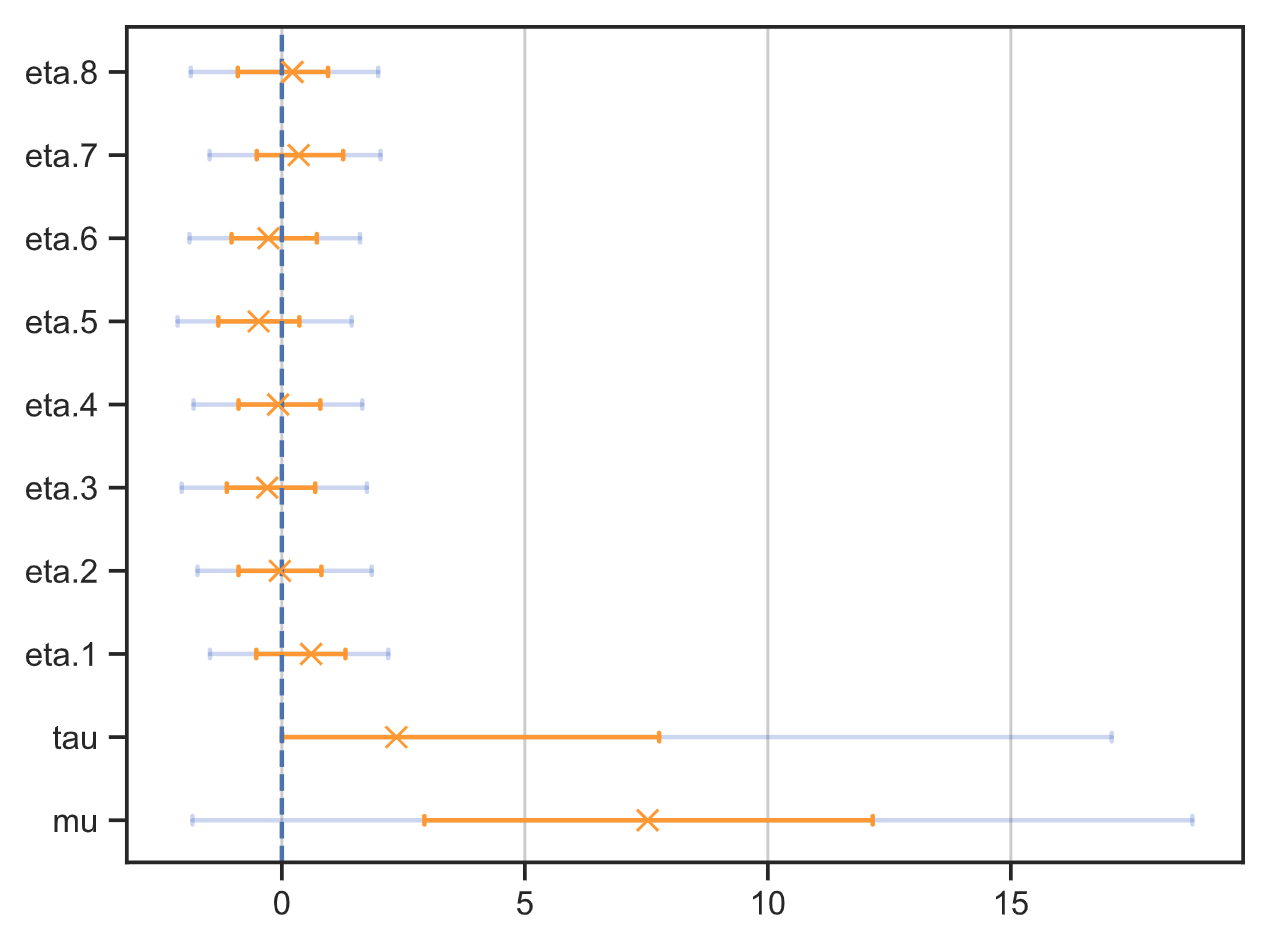
Tree plot without cmdstanpy
One can make a tree plot by supplying a Panda's data frame that shows summaries of values for the frame's columns:
from tarpan.shared.tree_plot import save_tree_plot
save_tree_plot([df], param_names=['mu', 'sigma'])
Comparing multiple models on a tree plot
Supply multiple fits in order to compare parameters from multiple models.
from tarpan.cmdstanpy.tree_plot import save_tree_plot
from tarpan.shared.tree_plot import TreePlotParams
# Sample from two models
model1 = CmdStanModel(stan_file="your_model1.stan")
fit1 = model1.sample(data=your_data)
model2 = CmdStanModel(stan_file="your_model2.stan")
fit2 = model2.sample(data=your_data)
# Supply legend labels (optional)
tree_params = TreePlotParams()
tree_params.labels = ["Model 1", "Model 2", "Exact"]
data = [{ "mu": 2.2, "tau": 1.3 }] # Add extra markers (optional)
save_tree_plot([fit1, fit2], extra_values=data, param_names=['mu', 'tau'],
tree_params=tree_params)
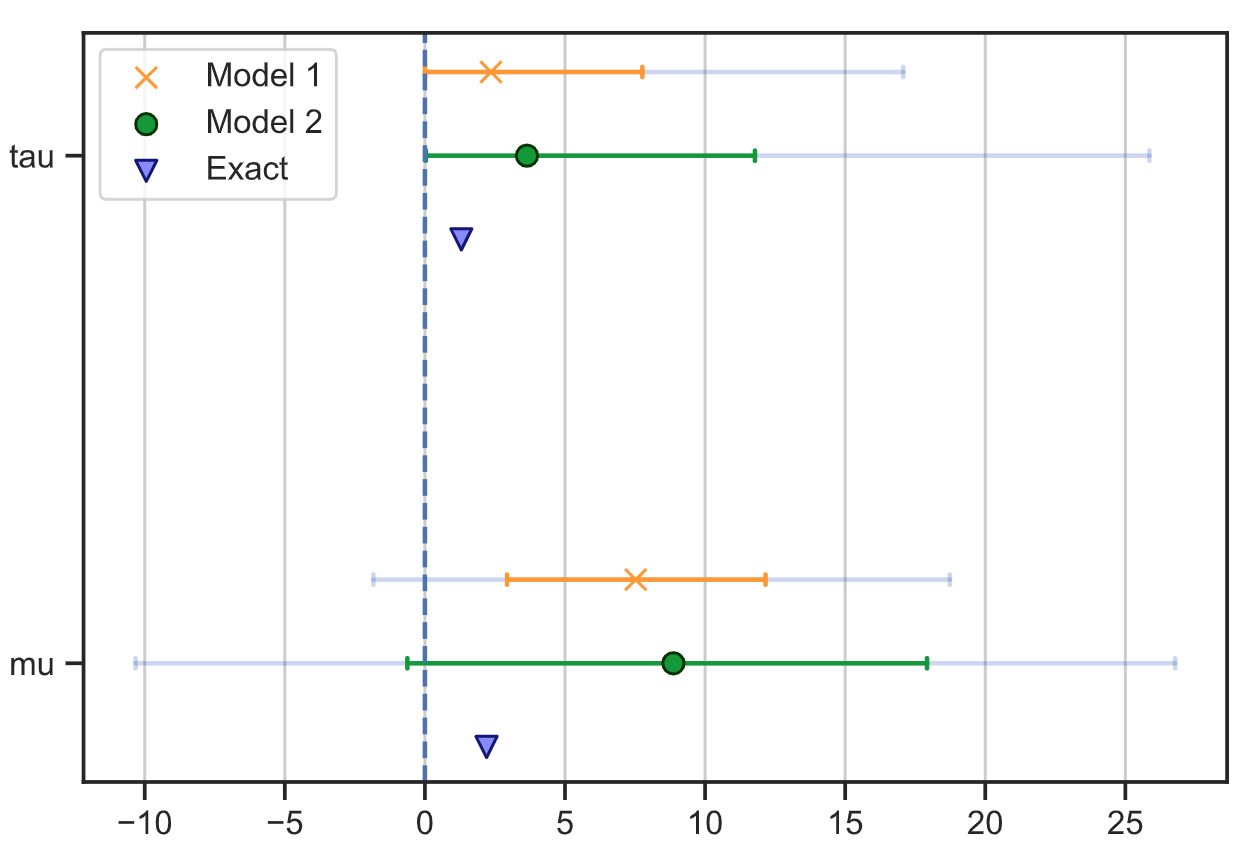
Comparing parameters of multiple models
Use save_compare_parameters function to compare parameters in one table like this:
| mu | tau | |
|---|---|---|
| Model 1 | 7.53 (+4.63, -4.59) | 2.36 (+5.41, -2.35) |
| Model 2 | 8.87 (+9.05, -9.50) | 3.64 (+8.14, -3.61) |
This table is a numerical version of the data shown by save_tree_plot. The values here are modes of the distributions and uncertainties are distances to 68% HPD intervals.
from tarpan.cmdstanpy.compare_parameters import save_compare_parameters
save_compare_parameters([fit1, fit2], labels=['Model 1', 'Model 2'],
param_names=["mu", "theta"])
Use save_compare_parameters without cmdstanpy
Here is how to compare parameters using Pandas data frames df1 and df2:
from tarpan.shared.compare_parameters import save_compare_parameters
save_compare_parameters([df1, df2], labels=['Model 1', 'Model 2'],
param_names=["mu", "theta"])
Trace plot: save_traceplot
The plot shows the values of parameters samples. Different colors correspond to samples form different chains. Ideally, the lines of different colors on the left plots are well mixed, and the right plot is fairly uniform.
from tarpan.cmdstanpy.traceplot import save_traceplot
model = CmdStanModel(stan_file="your_model.stan")
fit = model.sample(data=your_data)
save_traceplot(fit, param_names=['mu', 'tau', 'eta.1'])
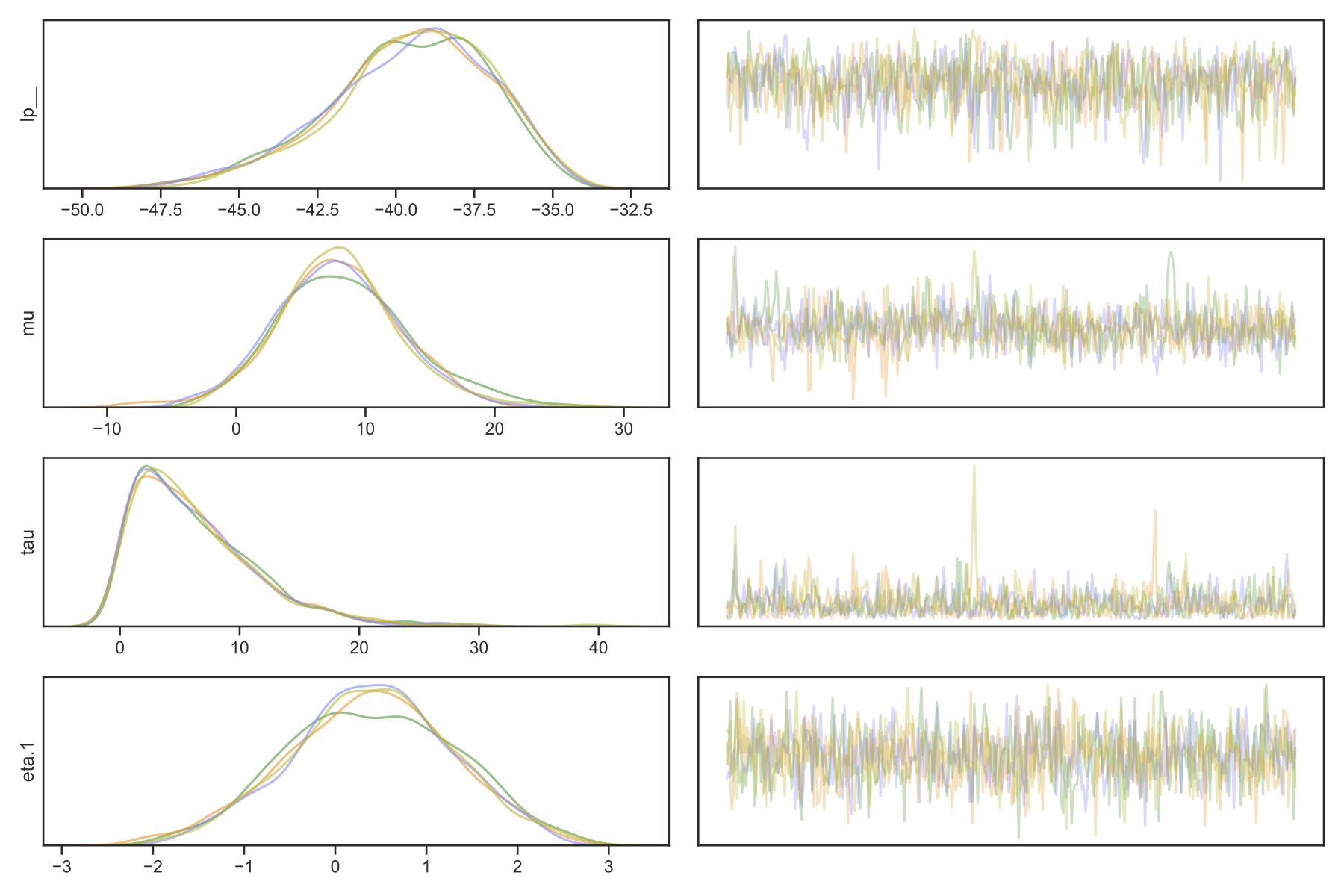
Pair plot: save_pair_plot
The plot helps to see correlations between parameters and spot funnel shaped distributions that can result in sampling problems.
from tarpan.cmdstanpy.pair_plot import save_pair_plot
model = CmdStanModel(stan_file="your_model.stan")
fit = model.sample(data=your_data)
save_pair_plot(fit, param_names=['mu', 'tau', 'eta.1'])
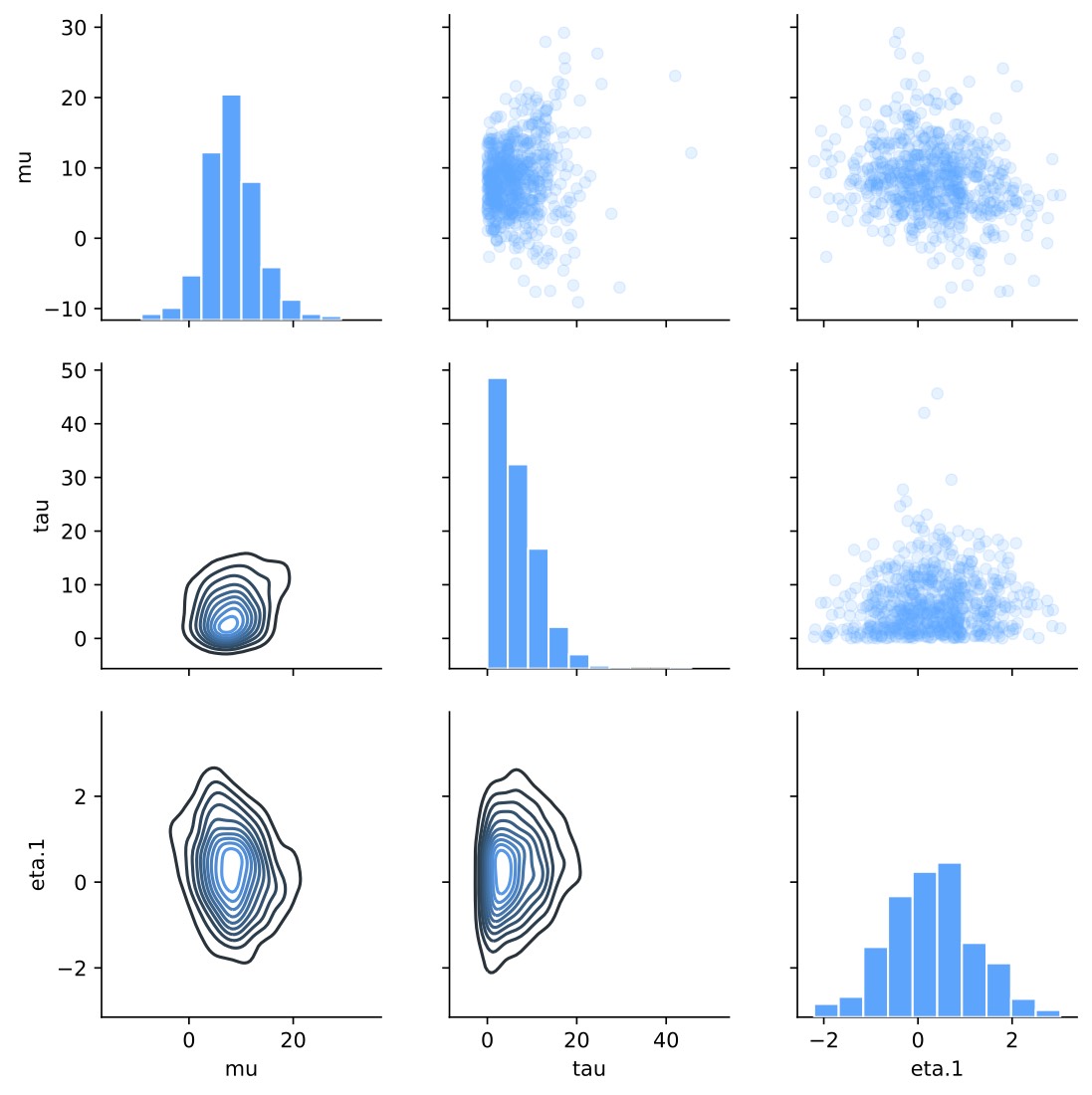
Pair plot without cmdstanpy
Here is how to make a pair plot of values from Pandas' data frame columns:
from tarpan.shared.pair_plot import save_pair_plot
save_pair_plot(df, param_names=['mu', 'sigma'])
Histogram: save_histogram
Show histograms of parameter distributions.
from tarpan.cmdstanpy.histogram import save_histogram
model = CmdStanModel(stan_file="your_model.stan")
fit = model.sample(data=your_data)
save_histogram(fit, param_names=['mu', 'tau', 'eta.1', 'theta.1'])
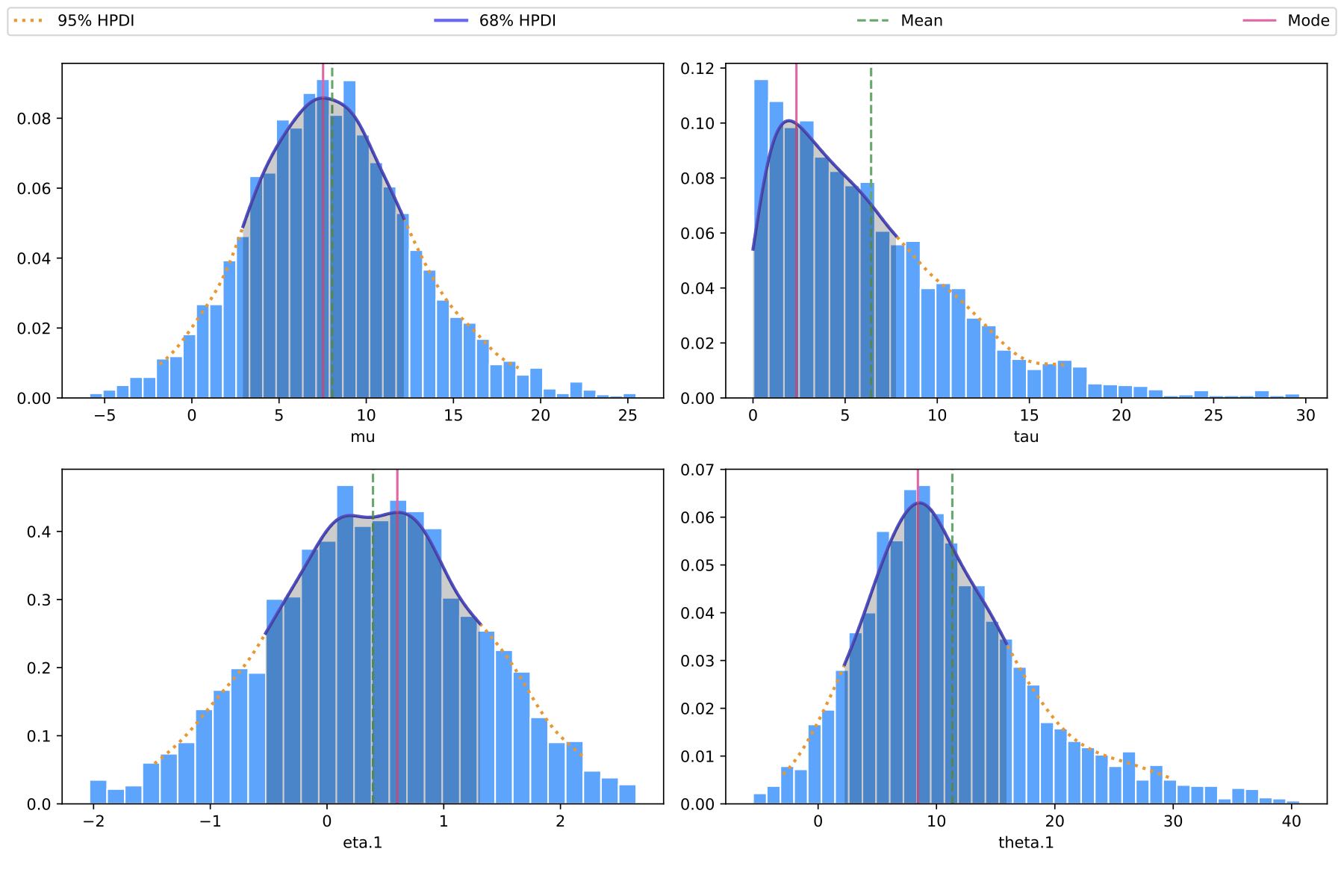
Histogram without cmdstanpy
Here is how to make histograms of values from Pandas' data frame columns:
from tarpan.shared.histogram import save_histogram
save_histogram(df, param_names=['mu', 'sigma'])
Saving cmdstan samples to disk
It saves a lot of time to sample the model and save the results to disk, so
they can be used on the next run instead of waiting for the sampling again.
This can be done with run function:
from tarpan.cmdstanpy.cache import run
# Your function that creates CmdStanModel, runs its `sample` method
# and returns the result.
#
# This function must take `output_dir` input parameter and pass it to `sample`.
#
# It may also have any other parameters you wish to pass from `run`.
def run_stan(output_dir, other_param):
model = CmdStanModel(stan_file="my_model.stan")
fit = model.sample(
data=data,
output_dir=output_dir # Pass to make CSVs in correct location
)
return fit # Return the fit
# Will run `run_stan` once, save model to disk and read it on next calls
fit = run(func=run_stan, other_param="some data")
Scatter and KDE plot
The save_scatter_and_kde function saves a scatter and corresponding KDE (kernel density estimate) plot. The KDE plot takes into account uncertainties of individual values:
from tarpan.plot.kde import save_scatter_and_kde
values1 = [
-0.99, -1.37, -1.38, -1.51, -1.29, -1.34, -1.50, -0.93, -0.83,
-1.46, -1.07, -1.28, -0.73]
uncertainties1 = [
0.12, 0.05, 0.11, 0.18, 0.03, 0.19, 0.18, 0.12, 0.19,
0.09, 0.11, 0.16, 0.08]
values2 = [
-1.22, -1.15, -0.97, -0.68, -0.37, -0.48, -0.73, -0.61, -1.32,
-0.62, -1.13, -0.65, -0.90, -1.29, -1.19, -0.54, -0.64, -0.45,
-1.21, -0.75, -0.66, -0.71, -0.61, -0.59, -1.07, -0.65, -0.59]
uncertainties2 = [
0.13, 0.14, 0.17, 0.07, 0.11, 0.12, 0.23, 0.05, 0.04,
0.30, 0.11, 0.13, 0.16, 0.03, 0.18, 0.20, 0.16, 0.16,
0.11, 0.09, 0.20, 0.10, 0.08, 0.04, 0.04, 0.23, 0.19]
save_scatter_and_kde(values=[values1, values2],
uncertainties=[uncertainties1, uncertainties2],
title="Sodium abundances in RGB stars of NGC 288",
xlabel="Sodium abundance [Na/H]",
ylabel=["Star number", "Probability density"],
legend_labels=["AGB", "RGB"])
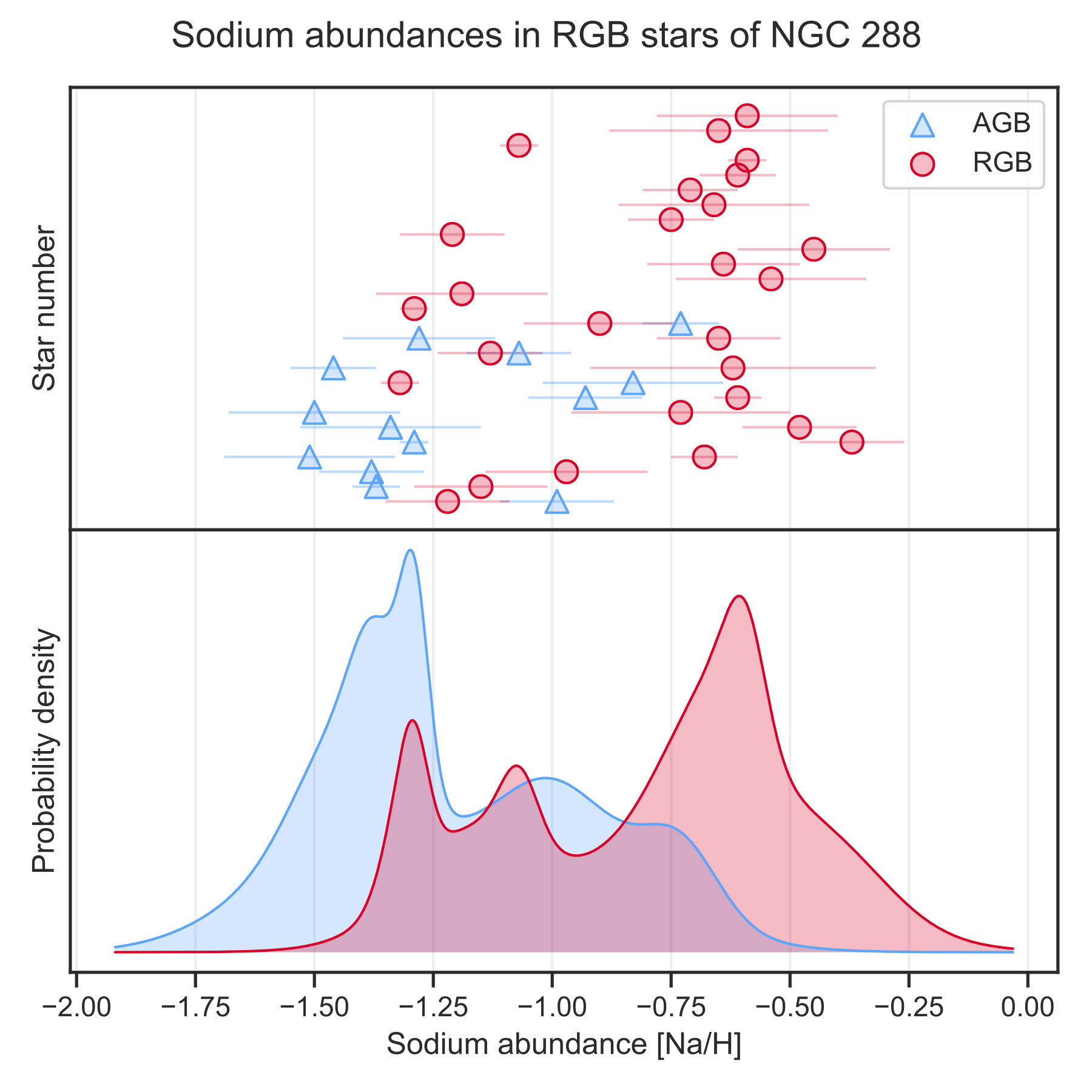
gaussian_kde function
The function returns the values for a KDE plot, taking into account uncertainties of individual values:
from tarpan.plot.kde import gaussian_kde
import numpy as np
import matplotlib.pyplot as plt
x = np.linspace(0, 1, 100)
y = gaussian_kde(x, values, uncert)
plt.fill_between(x, y)
Common questions
Run unit tests
pytest
The unlicense
This work is in public domain.
🐴🐴🐴
This work is dedicated to Tarpan, an extinct subspecies of wild horse.
Project details
Release history Release notifications | RSS feed
Download files
Download the file for your platform. If you're not sure which to choose, learn more about installing packages.











